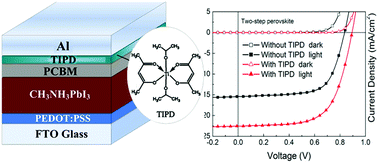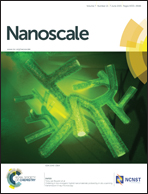Efficient perovskite/fullerene planar heterojunction solar cells with enhanced charge extraction and suppressed charge recombination†
Abstract
Alcohol soluble titanium chelate TIPD (titanium (diisopropoxide) bis(2,4-pentanedionate)) was used as an electron transporting layer to form an ohmic contact with the negative electrode, aiming to enhance the charge extraction and suppress the charge recombination for high performance CH3NH3PbI3/PCBM-based PHJ perovskite solar cells. The TIPD layer shows excellent suitability to CH3NH3PbI3 perovskite synthesized by different methods. For one-step synthesized CH3NH3PbI3, the power conversion efficiency (PCE) of the device with the TIPD buffer reaches 8.75%, with a nearly 33% increase in comparison with the device without the buffer layer (6.58%). For two-step synthesized CH3NH3PbI3, an open-circuit voltage (Voc) of 0.89 V, a short-circuit current density (Jsc) of 22.57 mA cm−2, and a fill factor (FF) of 64.5%, corresponding to a PCE of 12.95% for the device with a TIPD buffer layer were achieved, which is among the best performances reported in the literature for CH3NH3PbI3/PCBM-based PHJ perovskite solar cells.


 Please wait while we load your content...
Please wait while we load your content...